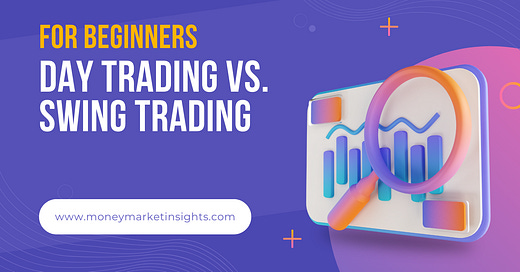Day Trading vs. Swing Trading: A Simple Investor's Guide
For individuals entering the world of stock trading, understanding the different strategies can be akin to navigating a maze.
Two popular approaches are day trading and swing trading, each with its own set of pros and cons. Let's delve into the basics of each strategy, along with some simple examples to illustrate their differences.
Day Trading:
Day trading involves buying and selling securities within the same trading day. Day traders aim to capitalize on small price movements and typically close out all positions before the market closes. This strategy requires close monitoring of the market and quick decision-making.
Pros:
Quick Profits: Day traders can potentially make profits within a single trading session.
Reduced Overnight Risk: Since positions are closed by the end of the day, day traders are not exposed to overnight market fluctuations.
High Trading Frequency: Day trading allows for multiple trades in a day, providing more opportunities for profit.
Cons:
High Risk: The fast-paced nature of day trading can lead to significant losses if trades go against the trader.
Stressful: Constant monitoring of the market and rapid decision-making can be mentally taxing.
Requires Time: Day trading demands full attention during market hours, making it unsuitable for those with other commitments.
Example:
John, a day trader, buys 100 shares of XYZ Corp. at $50 each in the morning and sells them later in the day when the price reaches $55. He makes a profit of $500 ($5 x 100 shares) within a single trading session.
Swing Trading:
Swing trading involves holding positions for several days to weeks, aiming to capture larger price movements. Swing traders analyze trends and market patterns to identify potential entry and exit points.
Pros:
Less Time-Intensive: Swing trading allows for more flexibility as traders don't need to monitor the market constantly.
Potential for Larger Profits: By holding positions for longer periods, swing traders can capitalize on significant price movements.
Reduced Stress: Compared to day trading, swing trading can be less stressful as it doesn't require constant monitoring.
Cons:
Overnight Risk: Positions held overnight are vulnerable to market volatility and unexpected news events.
Delayed Returns: Profits may take longer to materialize compared to day trading.
Market Timing: Timing entry and exit points accurately can be challenging and may require more patience.
Example:
Sarah, a swing trader, identifies an upward trend in ABC Corp. She buys 200 shares at $60 each and holds them for two weeks until the price reaches $70. She then sells her shares, making a profit of $2,000 ($10 x 200 shares).
In conclusion, both day trading and swing trading offer opportunities for profit in the stock market. The choice between the two depends on individual preferences, risk tolerance, and time commitment. Simple investors should carefully consider their goals and resources before choosing a trading strategy that suits them best. Remember, regardless of the strategy, it's crucial to conduct thorough research and practice risk management to navigate the unpredictable nature of the market.
*Disclaimer: Not Financial Advice. Investors should conduct thorough research and seek professional advice before making any investment decisions.*



